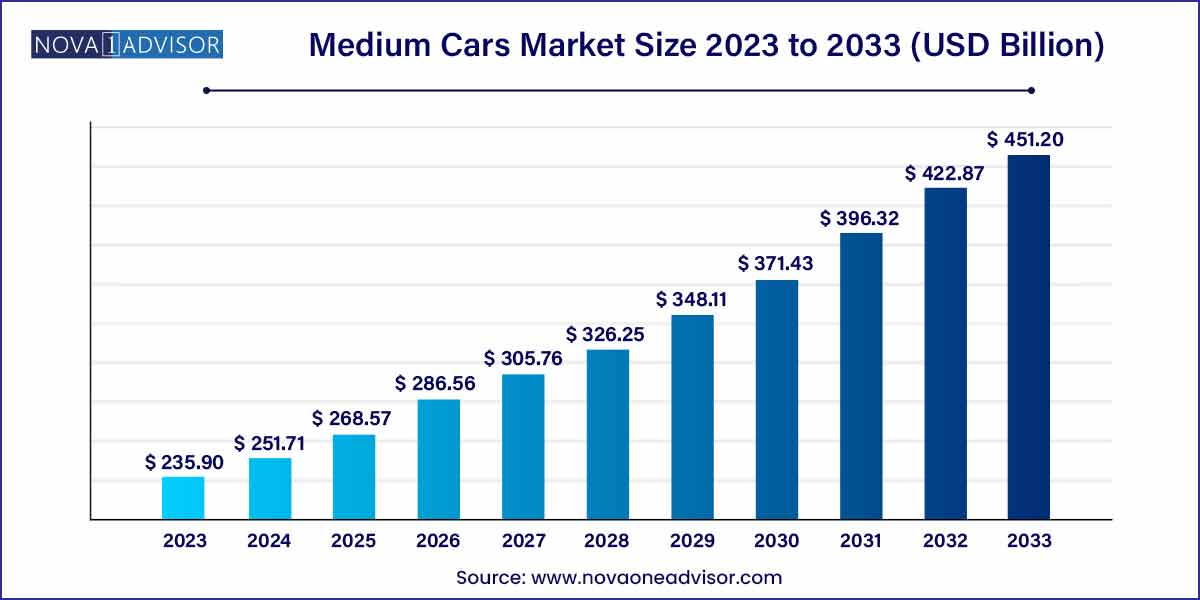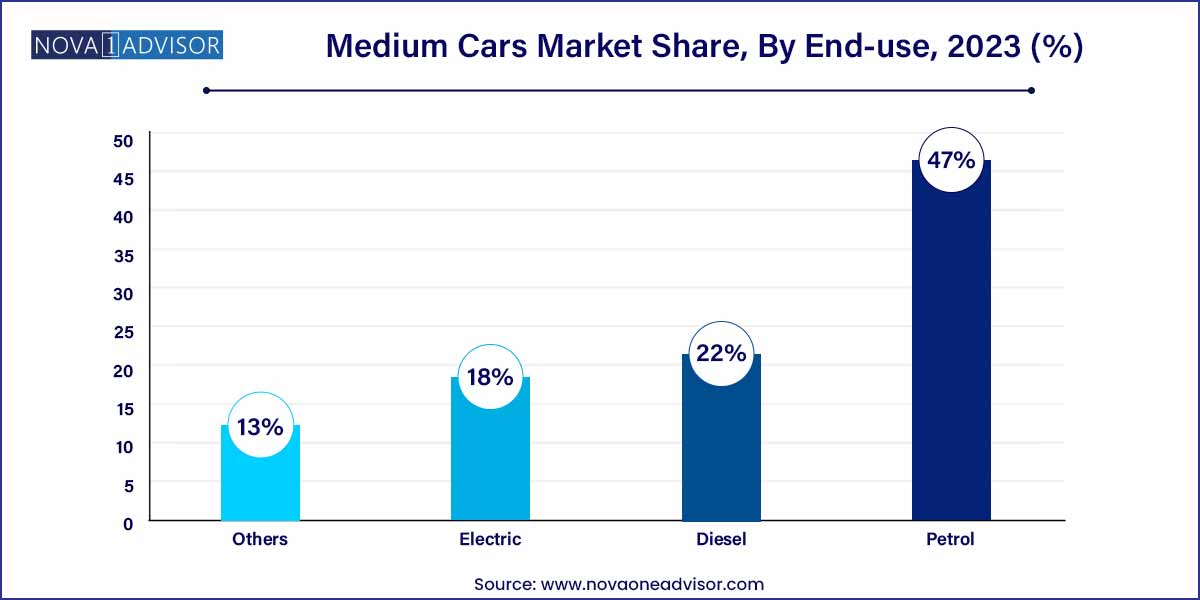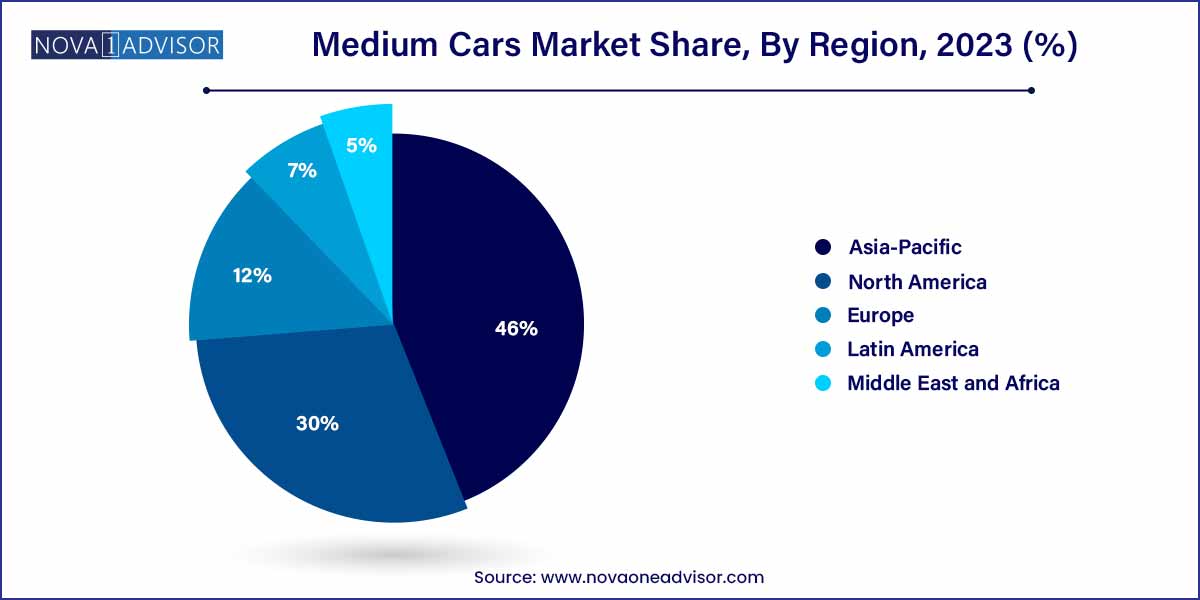The global medium cars market size was exhibited at USD 235.90 billion in 2023 and is projected to hit around USD 451.20 billion by 2033, growing at a CAGR of 6.7% during the forecast period of 2024 to 2033.

Key Takeaways:
- Asia Pacific held the largest revenue share of over 46.0% in 2023.
- Petrol-based medium cars held the largest revenue share of over 47.0% in 2023.
Medium Cars Market by Overview
The global medium cars market stands as one of the most resilient and versatile segments within the automotive industry. Medium-sized cars, typically defined by their balanced dimensions, offer a compelling mix of performance, comfort, affordability, and fuel efficiency. These vehicles have traditionally appealed to a wide demographic, from young professionals and small families to fleet operators and corporate clients. Unlike compact cars that prioritize economy or luxury cars that emphasize premium features, medium cars strike a harmonious balance, making them a preferred choice across multiple regions.
In recent years, the market has undergone a dynamic transformation due to technological advancements, stricter emission regulations, and evolving consumer preferences. Automakers are investing heavily in electric variants, hybrid technologies, and smart connectivity features to cater to a more environmentally conscious and digitally savvy consumer base. Furthermore, the rise of shared mobility, shifting urbanization patterns, and a growing middle class in emerging economies have provided significant impetus to the growth of the medium cars market.
Despite challenges like supply chain disruptions, fluctuating raw material costs, and the competitive pressures from SUVs and crossovers, the medium car segment remains robust. Its ability to adapt and cater to both practical and aspirational needs ensures that it continues to be an integral part of the global automotive landscape.
Medium Cars Market Growth
The growth of the medium-car market is propelled by several key factors that shape its trajectory. Firstly, technological advancements, particularly in electrification and automotive connectivity, continue to drive innovation and enhance the appeal of medium-sized vehicles. Additionally, shifting consumer preferences towards crossover utility vehicles (CUVs) contribute to market expansion, as these models offer a blend of versatility and practicality. Moreover, stringent emissions regulations and the growing emphasis on sustainability are encouraging automakers to invest in eco-friendly alternatives, thereby fostering market growth. Furthermore, economic factors such as rising disposable incomes and urbanization contribute to increased demand for medium cars, especially among urban dwellers seeking efficient and stylish transportation solutions. Overall, these growth factors underscore the dynamic nature of the medium-car market, presenting opportunities for manufacturers to capitalize on evolving trends and consumer needs.
Medium Cars Market Report Scope
| Report Coverage |
Details |
| Market Size in 2024 |
USD 235.90 Billion |
| Market Size by 2033 |
USD 451.20 Billion |
| Growth Rate From 2024 to 2033 |
CAGR of 6.7% |
| Base Year |
2023 |
| Forecast Period |
2024-2033 |
| Segments Covered |
Fuel Type, Region |
| Market Analysis (Terms Used) |
Value (US$ Million/Billion) or (Volume/Units) |
| Regional Scope |
North America; Europe; Asia Pacific; Central and South America; the Middle East and Africa |
| Key Companies Profiled |
Stellantis NV; Toyota Motor; Renault; Volkswagen; Hyundai Motor Company; Kia Corporation; Suzuki Motor Corporation; General Motors (Chevrolet); Ford Motor Company; BMW Group; Honda Motor Company, Ltd. |
Medium Cars Market Dynamics
The medium cars market dynamics are influenced by a myriad of factors, but two standout dynamics deserve attention. Firstly, the competitive landscape within the medium-car segment is characterized by intense rivalry among established players and emerging entrants. This competition drives innovation, product differentiation, and strategic marketing efforts as companies vie for market share and consumer attention. Brand reputation, reliability, and value proposition play pivotal roles in shaping consumer perceptions and purchasing decisions amidst this competitive environment.
Secondly, global economic factors significantly impact the medium cars market dynamics. Fluctuations in economic conditions, geopolitical tensions, and regulatory policies can influence consumer spending habits, production costs, and overall market demand. Adapting to these macroeconomic shifts requires agility and strategic foresight from industry stakeholders to mitigate risks and capitalize on emerging opportunities. By staying attuned to economic trends and regulatory developments, companies can navigate uncertainties and position themselves for sustainable growth in the medium-car market.
Medium Cars Market Restraint
In the medium cars market, two prominent restraints exert considerable influence on its dynamics. Firstly, the saturation of the market poses a significant challenge for manufacturers and marketers alike. With a plethora of options available to consumers, standing out amidst the crowded marketplace becomes increasingly difficult. This saturation can lead to price wars, margin pressures, and a greater emphasis on promotional activities, impacting profitability and brand differentiation.
Secondly, the emergence of alternative transportation solutions, such as ride-sharing services and micro-mobility options, presents a notable restraint to the medium cars market. These alternatives offer convenient and cost-effective transportation solutions, particularly in urban areas, reducing the reliance on personal vehicle ownership. As a result, medium car sales may face stagnation or decline in certain demographic segments, posing a challenge for manufacturers to adapt their business models and product offerings to cater to evolving consumer preferences.
Medium Cars Market Challenges
In navigating the medium cars market, two significant challenges demand attention from industry stakeholders. Firstly, the escalating cost of research and development (R&D) poses a formidable challenge for manufacturers. With increasing consumer expectations for advanced features, safety enhancements, and technological innovations, automakers are under pressure to invest heavily in R&D to stay competitive. However, the rising R&D costs can strain profit margins and hinder affordability, especially in a market where price sensitivity plays a crucial role in purchasing decisions.
Secondly, shifting consumer preferences and evolving mobility patterns present a complex challenge for medium car manufacturers. The rise of shared mobility services, urbanization, and changing demographics are reshaping the automotive landscape, impacting demand dynamics and market trends. Adapting to these shifts requires agility and foresight from manufacturers to align their product offerings with evolving consumer needs while anticipating future trends. Failure to accurately anticipate and respond to changing preferences can result in product obsolescence and loss of market relevance, posing a significant challenge for medium car manufacturers striving to maintain their competitive edge in a rapidly evolving market landscape.
Segments Insights:
Fuel Type Insights
Petrol-powered medium cars dominated the fuel type segment of the medium cars market. Historically, petrol vehicles have been the mainstay due to their lower upfront cost, widespread availability, and smoother driving experience. Even as the industry pivots towards greener alternatives, petrol medium cars like the Toyota Corolla and Honda Civic continue to enjoy strong sales, particularly in regions where electric vehicle infrastructure is still developing. Petrol engines offer a balance of power and efficiency, making them ideal for daily commuting and occasional long-distance travel.

Meanwhile, Electric medium cars are witnessing the fastest growth rate within the fuel type segment. Driven by favorable government policies, advancements in battery technology, and the increasing affordability of EVs, electric medium cars are gaining significant traction. Models like the Tesla Model 3 and BYD Seal are becoming increasingly popular choices among eco-conscious consumers. The shift towards electrification is particularly pronounced in Europe and China, where stringent emissions regulations and consumer incentives are accelerating the transition.
Regional Insights
Asia-Pacific dominated the global medium cars market in terms of volume and value. The region is home to some of the world's largest automotive markets, including China, Japan, India, and South Korea. In China, medium-sized sedans and hatchbacks are favored for their affordability, practicality, and improving technological sophistication. Japanese brands like Toyota, Honda, and Nissan have a strong foothold in both domestic and international markets, offering reliable medium cars that cater to a broad range of consumers. The growth of urban centers, rising disposable incomes, and supportive government policies for both ICE and EV models have cemented Asia-Pacific's leadership in this market.

Europe is emerging as the fastest-growing region for the medium cars market. European consumers traditionally preferred smaller cars, but medium-sized vehicles are gaining popularity, particularly electric and hybrid models. The European Union's aggressive push towards carbon neutrality, combined with substantial incentives for electric and hybrid vehicle purchases, is reshaping consumer behavior. Germany, France, and the UK are leading this transition, with strong sales of models like the Volkswagen ID.4, Peugeot 508, and BMW i4. Moreover, heightened environmental consciousness and urban low-emission zones are driving the demand for newer, cleaner medium cars.
Some of the prominent players in the medium cars market include:
- Stellantis NV
- Toyota Motor
- Renault
- Volkswagen
- Hyundai Motor Company
- Kia Corporation
- Suzuki Motor Corporation
- General Motors (Chevrolet)
- Ford Motor Company
- BMW Group
- Honda Motor Company, Ltd.
Segments Covered in the Report
This report forecasts revenue growth at global, regional, and country levels and provides an analysis of the latest industry trends in each of the sub-segments from 2021 to 2033. For this study, Nova one advisor, Inc. has segmented the global medium cars market.
Fuel Type
- Petrol
- Diesel
- Electric
- Others
By Region
- North America
- Europe
- Asia-Pacific
- Latin America
- Middle East & Africa (MEA)



